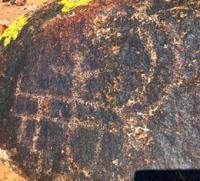Вы здесь
Petroglyphs of Aravan Rock.

Tours to Osh region.
«Memory is the treasure house of the mind wherein the monuments thereof are kept and preserved»
Thomas Fuller.
Trip from Osh to Aravan village.
The site is Aravan Rock (Duldul-Ata) on the eastern edge of the village with the same name, the district capital, 27km west of Osh. Geographic coordinates: NL 72 30 40.0, EL 40 30 42.60; altitude: 772m above sea level. Description of the Site.
In the scientific literature, the site is more commonly known as Aravan Rock. In 1946, Bernshtam N.A. described two groups of petroglyphs at different levels. The upper group is at a height of 15m from the foot of the rock and consists of large (0.5 – 1.1m) drawings of horses pecked using a fine-dot technique.
The horses are visible from a distance because they Rock Art in Central Asia 64 were refreshed by local enthusiasts in the early 1990s, when the site was visited by an international UNESCO expedition “The Great Silk Road” -a route of dialogue of the peoples”.
Bernshtam registered drawings of three argali sheep walking to the left (16 - 17cm), humans and two unidentified figures on the same surface. Below and to the left, there is another side-drawn human figure, two spectacle-like signs and a dog.
Below and to the right are drawings of a deer with branchy antlers and dogs, as well as three small human figures one over another. Three meters below, is another pair of similar horses. The drawings date to different periods; according to technique and stylistic specifics, Bernshtam dated the horses and a deer to the Saki period, assuming that this location had already been a sacred place then, and at the end of the 1st millennium BC the tradition continued as evidenced by “Davanian” horses, also objects of worship.
Nowadays, the earlier composition is very poorly preserved; the lower drawing of a pair of horses is almost invisible, and so is the chiseled circle with a deepening above the upper pair of horses, which was noted by Masson M.E. in 1939 (Masson 1948: 132).
Examination of the site in 2009 to the south-east of the main rock in different parts of the rocky range enabled to find other petroglyphs: a stallion (78 x 83cm), goats, and a composition of 16 drawings of animals, including dogs, leopard and wild boar, whose body is decorated with lines in a grid. At the entrance to a small cave, there is a single horse.
The last site is 0.5km to the east of Aravan Rock. There are four horses engraved on a separate rock. Near the foot of the main rock, there is a spring, a burial worshipped as the grave of Saint DuldulAta, and a mosque with an inscription reading this is the mosque of Duldul’s horse.
National tradition relates this place to Prophet Ali who, allegedly, tied his horse here when he headed for a battle with a White Dev who lived in Chil-Ustun cave; also located near Aravan in Charbak. To the west of the mazar, a horizontal surface has a multitude of pecked and abraded cup-holes 2–19cm in diameter and up to 14cm deep.
In its vicinity, there is a “childehana” (“chillyahana” – especially designated place), a naturally enclosed space between rocks without a ceiling with a very narrow passage leading to it; tree branches nearby are adorned with shreds of fabric tied by the pilgrims.
The place is designed for special rituals related to female fertility. Inside the childehana, there is a phallus-shaped fetish rock used in rituals performed by women; a fire is lighted on both its sides near the walls of the childehana. Visitors’ inscriptions are dated to the beginning of the XXth century, some of them have historical value.
The site is included in the “National List of Historical and Cultural Sites of the Republic of Kyrgyzstan of National Importance”. However, the boundaries of the site and its protection area have not yet been established.
Local community and sheikhs who permanently reside on the territory actually provide physical protection for the site; they also maintain order, improve the site, pray and perform rituals to receive voluntary contributions from pilgrims (Amanbaeva & Skripkina 2007: 66 - 67).
Nowadays, the location with childehana and a stone with cup-holes is the private property of one of the mazar custodians.
Authority:
«Rock Art in Kyrgyzstan». Bakyt Amanbaeva, Aiday Suleymanova, Chynarbek Zholdoshev.
Photos by
Alexander Petrov.







